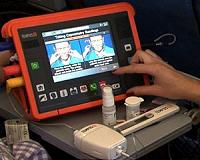 |
Berlin, Germany (SPX) Oct 13, 2010 Dentists and their patients will soon benefit from a tiny new high-resolution X-ray camera. A Swedish company has adapted an advanced technique used for miniaturising space hardware to make a visit to the dentist a little more comfortable. The camera takes X-ray pictures that are dramatically more detailed and with higher contrast than the conventional X-ray machines widely used by dentists today. The heart of the camera is a tiny 'structured scintillator' device that converts X-rays to visible light. The camera was designed by the Scint-X company and the key element - the scintillator - was built by Swedish company Nanospace, drawing on their experience of producing space systems. In fact, the production technology has already been used by Nanospace to cut the world's smallest rocket motor out of silicon wafers. "Our scintillator uses a specially structured silicon substrate and with this unique and patented manufacturing technique we can obtain substantially higher resolution than what is on the market today," explains Per Wiklund of Scint-X. Another advantage is that the X-ray unit inserted into the patient's mouth is much thinner than today's models, making the procedure more comfortable.
Space production paved the way Using a scintillator to convert X-rays into visible light is well established, but so far the low resolution has been a limitation. The breakthrough came when Scint-X produced the scintillator in the new structured silicon and asked Nanospace to build it in their high-precision 'micro-electro-mechanical system' (MEMS) facility. "The investment in our special machine [to produce MEMS] was entirely driven by the demand for capacity and quality in our production for space projects," says Tor-Arne Gronland, CEO of Nanospace. "Later, a number of non-space companies and research groups, such as Scint-X, have taken advantage of the processes and the capacity we now have." Nanospace used MEMS to build the miniature rocket motor flying on Prisma, a Swedish technology demonstration satellite launched in June 2010. Measuring only 51mm by 43.5mm, it is a complete micropropulsion system for precision control of a small satellite. Nanospace is working with ESA on the use of MEMS to provide miniaturised solutions for many of the fluid-handling components required in satellite propulsion systems. "ESA funded the research and development of the MEMS cold-gas thrusters that is now performing its first flight on Prisma," says Fabien Filhol from ESA's Product Assurance and Safety Department. "Now ESA is exploring with Nanospace the limits of this emerging MEMS-based micropropulsion technology for high-accuracy propulsion applications." Scint-X's innovative technology also has potential for use in space. The Swedish Space Corporation is planning to use the camera aboard a rocket planned to be launched in May 2011 by ESA. "Our camera provides a resolution that is better than five microns and will be used to study the melting and solidification of metals when producing exotic materials in weightlessness," explains Wiklund. "The synergy between space and non-space research and development, as in the case of Scint-X, illustrates the potential of technology transfer," explains Frank M. Salzgeber, Head of ESA's Technology Transfer Programme Office. "An advanced production technology set for space systems makes the development possible for a non-space orthodontic camera, which then can result in an innovative instrument for research in space."
Share This Article With Planet Earth
Related Links Scint-X Nanospace Technology at ESA Space Medicine Technology and Systems
 ESA Emergency Telemedicine System Soars To Commercial Success
ESA Emergency Telemedicine System Soars To Commercial SuccessParis, France (ESA) Sep 23, 2010 'Is there a doctor on the plane?' Piping this request over aircraft speakers is the traditional response to a potential onboard medical emergency. But now the availability of expert medical advice can be guaranteed every time. Etihad Airways, national carrier of the United Arab Emirates, is the latest airline to install the ESA-derived Tempus IC telemedicine system on its long-haul flights ... read more |
|
| The content herein, unless otherwise known to be public domain, are Copyright 1995-2010 - SpaceDaily. AFP and UPI Wire Stories are copyright Agence France-Presse and United Press International. ESA Portal Reports are copyright European Space Agency. All NASA sourced material is public domain. Additional copyrights may apply in whole or part to other bona fide parties. Advertising does not imply endorsement,agreement or approval of any opinions, statements or information provided by SpaceDaily on any Web page published or hosted by SpaceDaily. Privacy Statement |